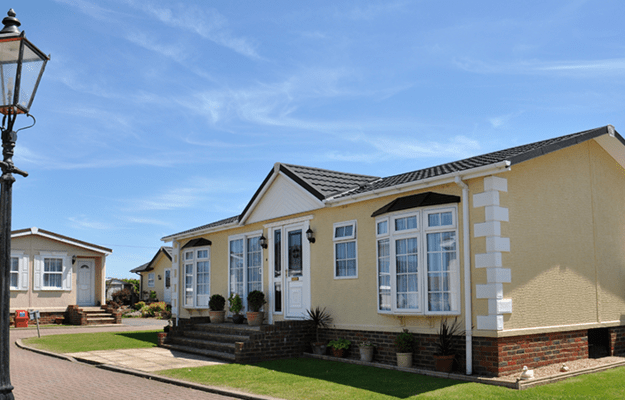
(Rosamar/Shutterstock)
How Does Resident-Ownership Influence Climate Adaptation in Manufactured Housing Communities?
- Title:
-
Resident-Owned Resilience: Can Cooperative Land Ownership Enable Transformative Climate Adaptation for Manufactured Housing Communities?
- Author:
-
Zachary Lamb, Linda Shi, Stephanie Silva, Jason Spicer
- Source:
- Publication Date:
-
2022
Residents of low-income manufactured housing communities (MHCs), the largest source of unsubsidized affordable housing in the United States, face unique environmental, housing, and economic vulnerabilities.
Social stigma against mobile homes and regulatory exclusion have pushed many MHCs to peripheral and nonresidential zones, including industrial zones, which are prone to environmental hazards and toxic exposure, and flood plains. Most MHCs lack even the most basic climate adaptive features because many units haven’t been updated since federal standards were instituted in the 1970s. Further, the vast majority (97.7 percent) of MHCs are owned by private investors who, in most states, don’t have any restrictions on lot rent increases. This leaves residents, even those who own their homes, vulnerable to eviction and housing cost burden.
To address these concerns, resident-owned communities (ROCs), in which communities collectively purchase and own the land beneath their mobile homes, have emerged as a growing alternative. The nonprofit organization Resident Owned Communities USA (ROC USA), whose model for cooperative ownership incorporates aspects of both traditional limited-equity cooperatives and community land trusts, hosts the largest network of ROCs in the country. Though evidence shows ROCs lower land rents and protect residents from eviction, research hasn’t assessed how resident ownership affects MHC residents’ climate vulnerabilities. This study fills this gap by assessing how, and how much, collective land ownership enables transformative climate adaptation.
To analyze ROC sites’ hazard vulnerability, researchers used data from ROC USA, the US Centers for Disease Control and Prevention’s Social Vulnerability Index, 2018 US Census Bureau socioeconomic data, Federal Emergency Management Agency 100- and 500-year floodplain maps, and the Spatial Hazard Events and Losses Database. To measure comparative rates of vulnerability between ROCs and other MHCs, researchers compared hazard risk and community demographics. Researchers also undertook extensive qualitative research, including a policy and procedure analysis of key ROC USA documents and 27 interviews with ROC USA stakeholders. Interviews focused on the challenges of transitioning MHCs to ROCs, experiences and awareness of climate hazards and infrastructure issues, and supporting community governance and management. Interviews were coded to extract key themes of resource challenges, social and institutional capacity to support ROCs, technical and experiential information about climate risks, and existing skills to manage and coordinate risk mitigation and response measures.
Key findings
- There are no major hazard risks or demographic variations between ROC USA communities and other MHCs. They are equally likely to be within 1,000 feet of a 100- or 500-year floodplain, have comparable rates of damage reports, have similar demographic and socioeconomic characteristics, and face similar social and physical hazard sensitivity. However, ROC USA intentionally limits its risk exposure by excluding MHCs with especially high environmental risk and infrastructure liabilities from joining their network.
- Conventional affordable housing financers (such as the US Department of Housing and Urban Development, philanthropies, and nonprofits) don’t commonly work with MHCs and work even more rarely with cooperatively owned communities like ROCs. This marginalization means ROCS rely heavily on technical assistance (TA) funding. TA providers are a key collaborator for ROCs, helping build relationships with conventional financers and finding place-based funding networks. To fill the gaps, ROC USA’s community financial development institution provides low-cost debt financing for cooperative acquisition and capital improvements. Diverse funding options expand how sites can fund climate adaptation.
- Social solidarity and trust are key factors in ROC USA sites’ ability to successfully prioritize climate resilience. Interviews demonstrated that resident commitment to the long-term well-being of the community influenced investments in adaptive measures like improved drainage and energy-efficient lighting.
- Residents’ experience with infrastructure failure and climate hazards is an essential information source, providing nuance and accuracy to property assessments. This deep understanding of the community’s vulnerabilities helps ensure capital and operations costs are accurately budgeted for and that the most urgent adaptive investments are prioritized. For example, after years of experiencing the consequences of poor roads, a predominately Latinx ROC in Houston, Texas, decided to invest in improving their drainage infrastructure. This foresight prevented the community flooding during Hurricane Harvey in 2017, which overwhelmed neighboring areas.
Policy and practice implications
- Though ROC USA communities are a promising pathway for households with low incomes to create stable self-governance, cooperative ownership (especially when lacking a climate focus) is no substitute for a public sector that actively addresses climate adaptation and hazard resilience in low-income communities. Policy platforms need to both enable the growth of resident ownership and invest in climate adaptation.
- State-level policies like improved notice-of-sale requirements, tenant-opportunity-to-purchase laws, and tax incentives for sales to residents can encourage the growth of the ROC USA model.
- To scale ROCs, the authors suggest there must be publicly funded supports in addition to nonprofits. They recommend that states should investigate creating programs like California’s Mobilehome Park Rehabilitation and Resident Ownership Program, which subsidizes resident purchase of MHCs by providing grants and low-interest loans.
- Because MHC residents are some of the most climate vulnerable in the US, the authors suggest policymakers should invest significant resources towards helping ROCs invest in climate action and mitigating risks. These resources could be financial (grants) or technical (targeting Green New Deal–oriented funding towards MHCs or creating new lending instruments through Fannie Mae and Freddie Mac to fund community-level infrastructure investments).
- ROCs can further support community-level adaptations to climate risks through measures like providing security of tenure to encourage homeowners to invest in upgrades like more secure foundations and improved insulation and mechanical systems for thermal comfort; enabling collective investments in upgrading community infrastructure systems including water, drainage, and sewer utilities; and facilitating shifts in settlement patterns to relocate homes away from hazard-prone sites.


